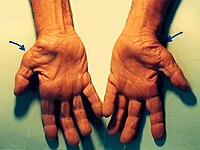Carpal Tunnel Syndrome

Carpal tunnel syndrome is a disorder caused by disturbances in nerve function (neuropathy), leading to pain and numbness or tingling (paresthesia) primarily in the wrist and hand. While carpal tunnel syndrome can occur at any age, it most often affects people between the ages of 40 and 60. In more than half of cases, both hands are affected; however, the severity may vary between hands. When only one hand is affected, it is most often the hand used for writing (the dominant hand).
In carpal tunnel syndrome, the pain or paresthesia is usually felt in the wrist, the palm, and the first four fingers of the hand. These signs and symptoms often develop during sleep and are noticeable upon waking. Affected individuals typically shake their hand to get rid of the pain and numbness, a characteristic move known as the flick sign. As the condition advances, the signs and symptoms begin to occur during the day as well. Affected individuals may have difficulty performing manual tasks such as turning doorknobs, fastening buttons, or opening jars. The symptoms of carpal tunnel syndrome may be triggered by certain activities that flex or extend the wrist, such as driving, typing, or holding a telephone.
Over time, people with carpal tunnel syndrome can have muscle and nerve wasting (atrophy) in the affected hand and a reduced ability to detect sensations, which can be mistaken for an improvement of symptoms.
Frequency
Carpal tunnel syndrome is estimated to affect 1 to 5 percent of the adult population.
Causes
Carpal tunnel syndrome occurs when a nerve in the hand and forearm, known as the median nerve, gets pinched (compressed) within a passage called the carpal tunnel. The carpal tunnel is a narrow canal at the wrist through which the median nerve extends from the forearm to the hand and the first four fingers. It is surrounded by the wrist bones and connective tissues, which are tissues that support the body's joints and organs.
Carpal tunnel syndrome is often described as idiopathic because its cause is frequently unknown but can be influenced by lifestyle factors. Little is known about the genetic contributions to this condition. Most of the genes that have been studied provide instructions for making proteins that are components of connective tissues. Other genes associated with the condition play roles in nerve cell function, the immune system, or metabolism. Additionally, the width of the carpal tunnel varies among individuals; people with narrower passages are more likely to have nerve compression than are people with wider passages.
In carpal tunnel syndrome, nerve compression can be caused by many factors including inflammation of connective tissues surrounding the carpal tunnel, accumulation of fluids (edema) in the lower arm, hormonal changes, stress and trauma to the wrist, or obstructions within the carpal tunnel, such as a cyst or tumor. Carpal tunnel syndrome occurs in 20 to 45 percent of pregnant women, likely due to edema or hormonal changes, and often goes away at the end of the pregnancy.
Particular activities, often related to certain occupations, may increase a person's risk of developing carpal tunnel syndrome. Repeated use of tools that vibrate or require forceful movements can put stress on the wrist, causing swelling or inflammation around the carpal tunnel. Whether repeated tensing of the hand and wrist, caused by frequent computer use, increases the risk of carpal tunnel syndrome is unclear; the evidence is conflicting. It is likely that the impact of computer use on the development of carpal tunnel syndrome is minor.
While carpal tunnel syndrome can be a feature of many disorders, including obesity, alcohol use disorder, rheumatoid arthritis, type 1 diabetes, type 2 diabetes, hypothyroidism, kidney (renal) failure, transthyretin amyloidosis, and hereditary neuropathy with liability to pressure palsies, it usually occurs in people with no related health conditions.
Learn more about the genes associated with Carpal tunnel syndrome
Additional Information from NCBI Gene:
Inheritance Pattern
Carpal tunnel syndrome is a complex condition and is usually not inherited. However, having a close relative with carpal tunnel syndrome likely increases a person's risk of developing the condition.
When carpal tunnel syndrome occurs as part of a genetic syndrome, this feature follows the inheritance pattern of the syndrome.